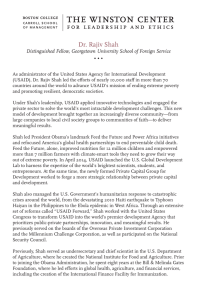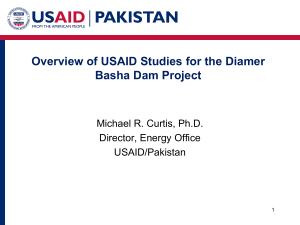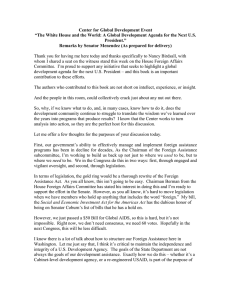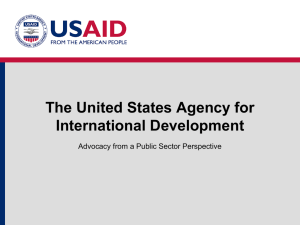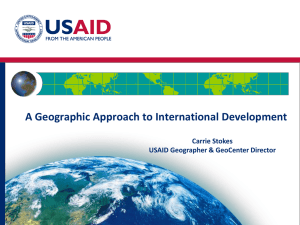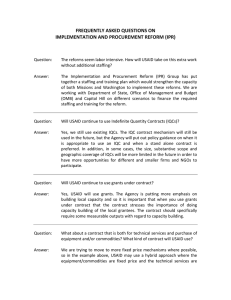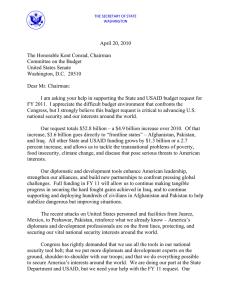center for global
advertisement
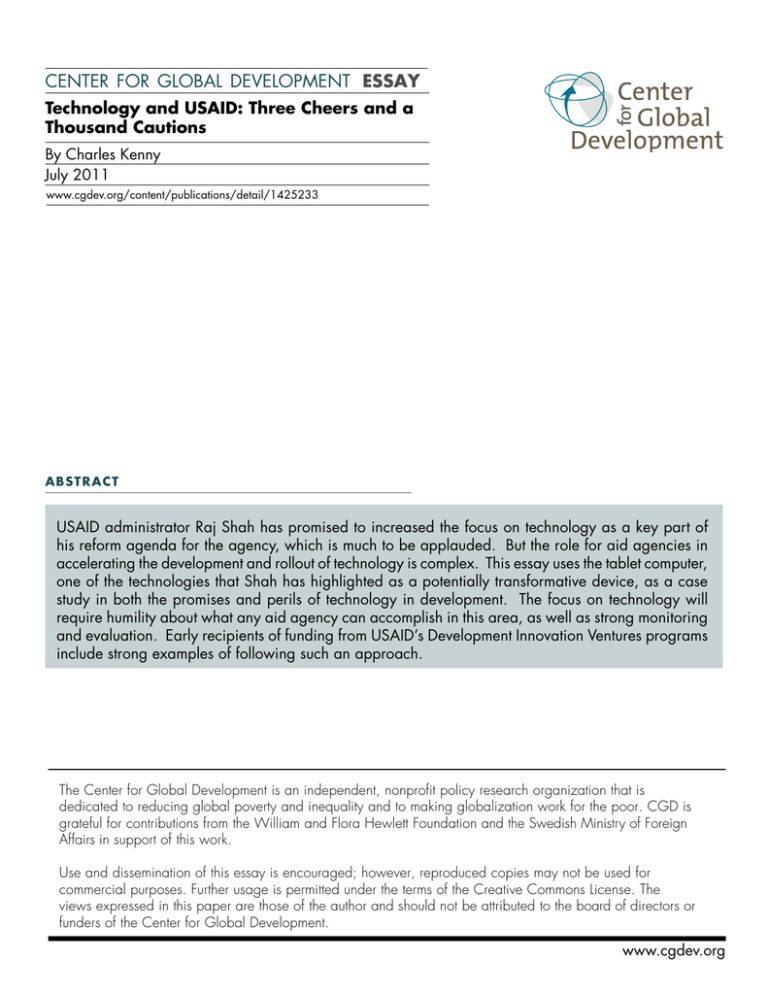
center for global development essay Technology and USAID: Three Cheers and a Thousand Cautions By Charles Kenny July 2011 www.cgdev.org/content/publications/detail/1425233 abst r a c t USAID administrator Raj Shah has promised to increased the focus on technology as a key part of his reform agenda for the agency, which is much to be applauded. But the role for aid agencies in accelerating the development and rollout of technology is complex. This essay uses the tablet computer, one of the technologies that Shah has highlighted as a potentially transformative device, as a case study in both the promises and perils of technology in development. The focus on technology will require humility about what any aid agency can accomplish in this area, as well as strong monitoring and evaluation. Early recipients of funding from USAID’s Development Innovation Ventures programs include strong examples of following such an approach. The Center for Global Development is an independent, nonprofit policy research organization that is dedicated to reducing global poverty and inequality and to making globalization work for the poor. CGD is grateful for contributions from the William and Flora Hewlett Foundation and the Swedish Ministry of Foreign Affairs in support of this work. Use and dissemination of this essay is encouraged; however, reproduced copies may not be used for commercial purposes. Further usage is permitted under the terms of the Creative Commons License. The views expressed in this paper are those of the author and should not be attributed to the board of directors or funders of the Center for Global Development. www.cgdev.org Technology and USAID: Three Cheers and a Thousand Cautions USAID administrator Raj Shah has promised an increased focus on technology as a key part of his reform agenda for the agency, reflecting widespread and bipartisan support for a greater emphasis on technological solutions for development challenges. Given the central role of technology in improvements in global quality of life, this focus is much to be applauded. But the role for aid agencies in accelerating the development and rollout of such technologies is very complex. This essay uses the tablet computer, one of the technologies that Shah has highlighted as a potentially transformative device, as a case study in both the promises and perils of technology in development. Shah discussed “transforming development through science, technology and innovation” at an event in Washington, D.C., last July, and he opened with a vision of the future: I want to start just by asking you to stretch your imagination a bit and transport yourselves to 2030 and imagine . . . we're traveling on a sort of bumpy rural road . . . in a West African country. And we meet with a farmer named Kwame. You might talk to Kwame and he would tell you that he can wake up early in the morning and check his low-cost, renewable-energy-powered tablet computer. . . . He can gather information about market prices. He can take photographs of his crops and send them into a cloud computing system where he has access to the world's agextension experts who can diagnose the pest infestation that he has in that specific situation. He can order in the right pesticides or the right support to help him improve his productivity and his yields and his production. . . . His kids would go to a school where they'd get the latest textbooks on Kindles that would be really cheap and require very little energy and [be] updated in a low-cost and efficient way so you wouldn't have this sort of big logistics on cost problem of accessing the most modern, the most adapted educational instruction information.1 Shah is surely correct that USAID should spend more time supporting transformative technologies for development, so this (re)engagement is very exciting. Technology is at the center of global improvements in the quality of life. At the same time, the relationship between technology and development is a complex one, and many technologies that look wonderful on paper fail miserably in the field. So the three cheers for USAID’s new engagement have to be accompanied by a thousand cautions. Perhaps most importantly, any technology initiative needs to be intimately tied in with USAID’s revived focus on monitoring and evaluation. * 1 * Shah, 2010. 1 * To start with the cheers, technology has driven improvements of quality of life worldwide in countries rich and poor, growing and stagnant alike. For example, it is thanks to technologies such as vaccines and antibiotics alongside the spread of ideas like handwashing that even countries which are as poor as they have ever been are seeing dramatically improved health. Nine million children born in 2005 were alive to celebrate their first birthday in 2006; they would have died if global mortality rates had remained unchanged since 1960.2 A lot of that improvement is due to the spread of vaccination programs. In 1980, many developing countries saw immunization rates considerably below 20 percent. Especially for poor countries, there has been a dramatic uptick in vaccination rates since then—so that a country with an income of about $1,000 per capita would expect to see a vaccination rate near eighty percent—and more than twice the rate predicted in 1980.3 It is not just in health that technology has played a dramatic role in improving the quality of life. The Green Revolution in agriculture saved the world from the threat of Malthusian famine. Advances in transport mean that more people have traveled further than ever before. The spread of communications technologies from the radio to the mobile phone have brought entertainment, education, comfort, and community to billions—the list goes on. Furthermore, the United States has played a considerable part in the invention and rollout of many of these technologies, not least by spreading the seeds of the Green Revolution and inventing and donating vaccines and drugs that have dramatically improved global health. And the country has considerable expertise and capacity for technology development in areas where poor people are looking for improved solutions in areas such as affordable small-scale off-grid power, high-yield crop varieties for African farms and vaccines for AIDS, malaria and cholera. So USAID should better marshal its resources—and those of others across the U.S. government—to tackle some of these challenges. The returns could be considerable. * * * At the same time, taking Shah’s 2030 vision as a jumping-off point, it might be worth examining the kind of difficulties that technologies designed to overcome development challenges can face. The administrator acknowledged some of them in his speech: “Everyone will say, well, a new technology costs a lot. . . . A second critique is appropriateness. . . . A third is capacity.” These are real issues, and some can be well illustrated using Shah’s example of the tablet computer as a tool for agricultural productivity and learning in West Africa. 2 Kenny 2011a. 3 Kenny 2011b. 2 First, it is worth noting how much the straightforward technology component of Shah’s story doesn’t seem far-fetched at all. Today you can get a new Kindle for $139 straight off Amazon’s website. Cheap mobile handsets are available for $15. The mobile signal spreads far enough that there were 4 billion mobile subscribers worldwide in 2008. By 2008, even 60 percent of sub-Saharan Africa’s population had mobile phone coverage.4 When it comes to renewable energy power, the price of solar voltaics has been dropping through the floor— around a two-thirds decline since 2006 alone. Solar powered lamps that come with a battery charging attachment as standard are already being produced.5 So, a renewable-powered tablet computer with web access working in rural West Africa by 2030 doesn’t sound like too much of a stretch. In fact, the technology component of Shah’s story appears so straightforward, it is a little hard to see where there is a role for USAID. Rollout of the wireless signal has been progressing fast enough that universal access funds designed to extend its reach in many parts of the world have been left in the dust, scrabbling around for other things to spend their money on. Low-cost computers designed for development like the One Laptop per Child project’s XO now face serious price competition from commercial laptops, and the Kindle itself is considerably cheaper.6 Beyond the supply-side issue of technology comes the frequently more complex issue of the demand side. Although with the mobile phone in particular, the incredible speed of rollout is based in large part on very strong demand. According to poor people themselves, the mobile is absolutely an “appropriate technology”—there is little demand-side complexity in this case. Survey evidence suggests that mobile phone expenditures equal between 3 and 8 percent of total incomes amongst poor people as a whole and can climb to as much as 20 percent or higher amongst poor mobile phone owners.7 A study in the Philippines found that mobile phone ownership lead to a 20 percent decline in monthly tobacco consumption. Apparently the mobile is more addictive than a cigarette.8 And strong demand reflects the incredible utility and impact of mobile phones to date.9 Jenny Aker finds that the introduction of mobile phones reduces dispersion of grain prices 4 Aker and Mbiti, 2010. 5 IFC ,2010 (figure 10). 6 Kraemer, Dedrick, and Sharma, 2009. 7 UNCTAD, 2010. 8 Labonne and Chase, 2008. 9 In Kerala, India, mobile phone service was introduced over the period from 1997 to 2001. One result was a dramatic improvement in the efficiency and profitability of the fishing industry. As mobile phone service spread, it allowed fishermen to land their catches where there were wholesalers ready to purchase them. This reduced waste from between 5 and 8 percent of total catch to close to zero and increased average profitability by around 8 percent. At the same time, consumer prices fell by 4 percent (Jensen, 2007). 3 across markets in rural Niger by 10 percent.10 Mobile phone coverage is associated with a 15 percent increase in employment in rural South Africa.11 And the impact of the mobile phone is only going to grow as new applications develop. For example, Kenya's M-PESA, a moneytransfer service that works over the mobile phone network, has 11.9 million customers, equal to about 54 percent of Kenya's adult population. The model is spreading throughout the developing world. So, put together declining prices and increasing reach with strong demand for mobile technologies, and the idea that a Kindle-type product might be owned by a rural farmer in West Africa in 2030 doesn’t seem outlandish at all—nor does the idea that it might be a real boon for development. At the same time, there are likely to be more demand side barriers to the rollout of internet-enabled computers in West Africa than there have been to the rollout of the mobile phone, and this is where the problem begins. There is already a rich literature on the subject of how the internet is an unlikely force for economic revolution in the developing world because of demand-side constraints.12 One illustration of the barriers faced by the internet in rural areas in particular is the Little Intelligent Communities project (or LINCOS for short). In 2001, a cooperative venture between MIT, Microsoft, Alcatel, and Costa Rica set out to show that a rural telecenter project could make a difference to the quality of life of the rural poor. LINCOS would provide access to telemedicine, distance education, and a range of other services. The venture created a rural center that did not require access to telephone lines or the electricity grid (utilizing solar and satellite technologies) at an investment cost of $20,000 per computer.13 Two years later, the project abandoned its rural base for the town of San Marcos, because the intended beneficiaries stayed away. Not that the project was an all-round failure: local coffee farmers, some of the richest people near the village of El Rodeo where the center was based, used the center to check coffee prices and register trademarks. It appears that the internet is far from irrelevant to some people in rural areas of developing countries, but not everyone sees the need—perhaps has the need—to access it. LINCOS was hardly alone in uncovering limited demand for telecenter services. A survey involving villages in Gujarat (India), Mozambique, and Tanzania all located near towns with internet access found very limited use indeed. “It was hoped that this report would provide information about use of and attitudes towards the Internet” wrote the researchers. “In practice, however, in spite of the availability of Internet facilities in local towns, less than two percent of those surveyed had ever made any use of these.” This compared to around 10 Aker, forthcoming. 11 Klonner and Nolen, 2008. 12 See Kenny, 2007. 13 Shakeel, Best, Miller, and Webber, 2001. 4 90 percent that had made use of a broadcast technology and between around 70 percent who used a telephone at least five times a year.14 Kentaro Toyama, a Microsoft computer scientist, toured 50 telecenters in South Asia and Africa and concluded “locals rarely saw much value in the Internet, and telecenter operators couldn’t market even the paltry services available.” Most shut down soon after they opened, he reported.15 The problem with internet telecenters is not primarily a technological issue, then. Limited demand is connected with the fact that the World Wide Web in all of its glory is a less “appropriate technology” than the stripped down simplicity of the mobile phone. MIT Media Lab’s Mike Dertouzos describes some of these demand-side challenges he faced when trying to think of innovative uses of the internet to help Nepal reduce poverty: We figured if anything could be done there that would demonstrate a quick jump in the country's GDP, it would be a great heroic act. Those were the naive days when we felt we could just get computers, connect them to the Net, and let them be used for health care, education and the usual things. We found out—and this is where I got my conclusion—that only 27 percent of the Nepalese are literate. The remaining 73 are not. So that is the first obstacle. The second one is that of the 27 percent who are literate, only five to eight percent speak, read and write in English. Of those, only a few hundred had any skill to sell. The obstacles of poverty became extremely visible and they drove the lesson home.16 Take the issue of literacy that Dertouzos highlights. While, by 2030, it is to be hoped that the vast majority of the world will have reached the 2015 Millennium Development Goal of universal primary education, there are still going to be a lot of children and adults alike with very limited literacy and numeracy skills. In the case of West Africa, Pritchett and colleagues report that only one-quarter of surveyed 15- to 19-year-olds in Ghana could answer more than half of a set of mathematics questions which involved four one-digit arithmetic questions (5–2=?) and four two-digit problems (17x3=).17 In Togo and Niger, only 60 percent of adults who had attained grade five could read and write with ease when tested.18 And to quote Bill Gates on the value of computers: “[t]he fundamental benefits of having a tool like this, 99 percent of the benefits come when you've provided reasonable health and literacy to the person who is going to sit down and use it.”19 Beyond the literacy challenge, there is the need for a supporting infrastructure to take full advantage of the kind of applications which Administrator Shah highlights. With regard to 14 Souter et al., 2005. 15 Toyama, 2010. 16 Dertouzos, 2001. 17 Filmer et al., 2006. 18 Terryn, n.d. 19 Gates, 2000. 5 the vision of the farmer taking photographs of stunted crops to send them into a cloud computing system where the world's ag-extension experts will opine as to what ails them, it is surely questionable that there are enough agricultural extension agents in the region or the world with the time or funding to be able to answer such questions from every small farmer in West Africa. There is also a question as to whether in 2030 FedEx will be delivering the seeds and pesticides the farmer orders on Amazon to rural Africa—along roads that remain bumpy. And will the farmer have the irrigation required to benefit from the fertilizer and advanced crops recommended in an environment of increasingly unreliable rainfall? Will he have the credit with which to buy them and the insurance against losing a more expensive crop? Again, will the farmer be able to get his crops to market along the bumpy roads and, once there, will the market work well enough to reward his investments? Better information is one key to development, and the internet is a powerful tool of information transfer. But information transfer is only one part of the development story. Similar issues apply to the second half of Shah’s vision, tablet computers as a tool for improved learning. There is much, much more to improved educational outcomes than a connection to the web. It is more than two decades since Al Gore described the revolution that the internet would bring to education: “a school child could plug into the Library of Congress every afternoon and explore a universe of knowledge.”20 Sadly, evidence form the United states suggests that, all too often, the kids are plugging into World of Warcraft instead; as internet connectivity improves, test scores go down.21 Across countries, there is no evidence that the availability of computers at school or home has any positive impact on student scores in internationally comparable tests.22 And direct studies of computer efficacy in schools conclude that while was some evidence that computers can improve standardized test scores, there are a number of studies with contradictory results, and a number of critical reviews of the positive studies.23 A study co-authored by Shah’s colleague in the administration, Austan Goolsbee, that looked at the e-rate subsidy program in California provides an example. The study suggested that the program had successfully incentivized schools to roll out the internet in classrooms, but the increased connections had no impact on student achievement.24 That is not to say computers never impact learning outcomes; indeed, there is some evidence of the efficacy of computer assisted learning in developing countries.25 But evidence suggests that the impact is far larger when computers are used as part of an integrated pedagogical program by knowledgeable and committed teachers. Sadly, the 20 Quoted in Cassidy, 2002. 21 Belo, Ferreira, and Telang 2010. 22 Hanushek and Woessmann, 2010. 23 Kirkpatrick and Cuban, 1998. 24 Goolsbee and Guryan 2006. 25 Banerjee et al., 2004. 6 atrocious literacy test scores described above reflect very weak schooling systems in many developing countries where such environments are lacking. Teacher absentee rates are high across the developing world. In unannounced visits to schools in Adhra Pradesh, India, for example, the chance that a civil service teacher was actually in a class and actively engaged in teaching during the school day was 28 percent.26 Added to this, the quality of education that teachers could provide even when they try is often limited by their low level of knowledge. A study in seven southern African countries found that many primary school mathematics teachers possessed only basic numeracy and actually scored lower than their students on the same tests.27 Kenneth Kraemer, Jason Dederick, and Prakul Sharma reviewed the disappointing record of the One Laptop per Child program in terms of revolutionizing education in the developing world and highlight these broader problems. They conclude that [d]iffusion of IT innovation does not depend only on the nature of the innovation itself. Often, more important is the social and cultural environment in which it will operate. Information technologies are not standalone innovations but system innovations, the value of which depends largely on an ecosystem that includes hardware, applications, peripherals, network infrastructure, and services (such as installation, training, repair, and technical support). Deployment involves training teachers, creating software and digital content, delivering maintenance and support, and sustaining a long-term commitment. Such capabilities are in short supply in developing countries and OLPC simply never had the resources to provide them. . . . Expecting a laptop to cause such revolutionary change showed a degree of naiveté, even for an organization with the best intentions and smartest people.28 Even studies which suggest an impact of computer-assisted learning in developing countries point out that there are considerably more cost-effective tools to get the same result.29 And the cost issue does remain particularly acute in this case. While computing costs have plummeted over recent years and will doubtless continue their fall, the dream of a tablet for every child really does face the issue of affordability in low-income countries. Yearly expenditures on teaching materials in primary schools in African countries are often pitifully low—$7 in Burkina Faso, $3 in Rwanda, 70 cents in Togo.30 It is hard to imagine tablet 26 Muralidharan and Sundararaman, 2008. 27 UNESCO, 2005. 28 Kraemer, Dedrick, and Sharma, 2009. 29 L. Linden, A. Banerjee, and E. Duflo, 2003. 30 This calculated from the World Bank’s edstats, multiplying 2007 values for percentage of current primary expenditure on teaching material by primary education expenditure per student as a percentage of per capita GDP and GDP per capita. Note that this will be an overestimate because primary education expenditure per student includes capital expenditure. 7 computers getting so cheap that schools could provide them for every student with these kinds of budgets, let alone stock them with any kind of useful texts.31 * * * The issues of cost, appropriateness and capacity that Administrator Shah highlighted in his speech certainly apply to the use of tablet computers in rural West Africa to increase agricultural productivity and improve educational outcomes, then. And they apply more broadly. Africa is scattered with the desiccated hulks of technological solutions that turned out to be less than miraculous. One recent example is the PlayPump, a merry-go-round attached to a pump that would draw water from a well as kids were spinning on the roundabout. But PlayPumps cost four times as much as traditional pump systems, they are complex and can’t be fixed with local labor or spare parts, and they aren’t efficient enough that a few hours of play produces much water.32 Many are now broken, blocking the well and forcing villagers to find water elsewhere. Play Pumps are joined by computers moldering in unused telecenters, tractors rusting, and advanced seeds rotting on small-scale farms as good ideas that frequently turned out not so well in practice. To repeat: the centrality of technology to improvements in the quality of life makes USAID’s renewed focus on technology and development both welcome and appropriate. At the same time, the challenges involved in rolling out technologies in developing countries suggest the both the need for realism and the centrality of evaluation. On the side of realism, it appears extremely unlikely that a USAID-financed project of a few million will deliver a new technology that will have a radical impact on the lives of a substantial part of the developing world—or indeed just West Africa. Silver bullets are sadly rare in development; otherwise, we wouldn’t still need USAID fifty years after its founding. There is a spectrum of activities involved in bringing technology to development, from invention to adaptation for developing-country settings to dissemination to end-users. There is also a range between public-good technologies (like vaccines) and private-good technologies (like solar stoves). All else equal, USAID should focus on adaptation and dissemination (rather than invention) and public, rather than private, good technologies. With regard to a focus on later stages of the innovation cycle, “blue sky” research is expensive, long-term, and difficult to direct towards particular challenges. USAID would do better working with potential beneficiaries to draw up a list of specific applications they 31 A particular cost issue involves the texts to be displayed on the tablet computers. A traditional role for donors in education has been to support the development and distribution of textbooks, but such programs are expensive. One factor that makes them particularly expensive is the continuing global expansion of copyright enforcement following considerable pressure from the U.S. government. 32 L. Freschi, 2010. 8 would consider of high value and which can be developed based on existing technologies. The agency could then encourage innovation to bring the application to market through prizes or advance market commitments (promising to purchase a given volume of an application which meets particular specifications at or below a set price). This suggests a focus on incremental products. In the case of tablet computers, for example, it may be that the better role for USAID would be to piggy-back on a set of technologies designed and marketed by the private sector to support the creation of content which has a development focus—on the model of the recent Apps for Development competition run by the World Bank or (indeed) USAID support for cash transfer via mobile phone in postearthquake Haiti.33 As to public versus private technologies, the agency’s resources are dwarfed by the research and development budgets of numerous private firms and, as the experience of both the mobile phone and the One Laptop per Child project suggests, where there is large private demand for a new product, there is already a large incentive for the private sector to develop it. Focusing where the private sector is likely to have least incentive to act alone will have a considerably greater potential impact. In particular this would cover public-good problems of limited concern to wealthy countries, such as adapting vaccines for use in developing countries. This was the target of the DfID-funded advance market commitment which has already brought to market a vaccine based on an existing developed world model for strains of pneumonia, meningitis and sepsis common in poor countries. Realism also demands understanding the customer. New product development is an inherently risky endeavor. That is why product rollout for new cereals or new cars is accompanied by focus groups, taste-testing, and market analysis. Surely the same should apply to products designed to relieve poverty where consumers are, perforce, incredibly picky. Product rollout is also accompanied by advanced marketing strategies. For many public-good technologies, social marketing is particularly important, suggesting that technology projects should specifically address marketing needs from the outset. Again, for many technologies, successful rollout may depend on regulatory or policy reform in developing countries to reduce costs and encourage adoption. And finally, given the high failure rate of technologies for development, improved monitoring and evaluation should be central. In this regard, Administrator Shah’s elevation of evaluation within USAID is hugely to be welcomed. Furthermore, It is important and encouraging to emphasize that Development Innovation Ventures, USAID’s new flagship “venture capital” program, has already funded in its first round a number of projects that follow the model of being incremental, public-good focused, and well evaluated. Not least among the initial awardees are a project to develop a 33 For more on Apps for Development, see http://appsfordevelopment.challengepost.com/. For more on USAID support for mobile phone service in Haiti, see Beubien, 2011. 9 low-cost self-test for pre-eclampsia that can be used by semiliterate pregnant women and a project that will use a randomized controlled trial to evaluate the effectiveness of a system where Afghan poll watchers send SMS pictures of polling center tallies to a central independent monitoring location, reducing the risk of electoral fraud. * * * A number of the biggest successes of aid have involved support for the development and rollout of new technologies. USAID should invest far more than it does in replicating those successes. And this is a particularly opportune time to do so. That is in part because of the development of new (and already successful) approaches to using aid money in this area. But this is also an opportune time because of Administrator Shah’s strengthened commitment to considerably improved monitoring and evaluation. With humility of purpose and a focus on testing product relevance, additional financing from USAID could have a considerable impact. The record of past technological fixes also suggests the agency should be ready for a number of failures along with the successes. But with good evaluation, I hope we will all be able to learn from both. 10 Bibliography Aker, J. Forthcoming. “Information from Markets Near and Far: The Impact of Mobile Phones on Agricultural Markets in Niger.” American Economic Journal: Applied Economics. Aker, J., and I. Mbiti. 2010. Mobile Phones and Economic Development in Africa. Journal of Economic Perspectives, 24(3): 207–32. Banerjee, A., et al. 2004. “Remedying Education: Evidence from Two Randomized Experiments in India,” mimeo, MIT. Beaubien, J. 2011. “In Haiti, Cell Phones Serve as Debit Cards.” NPR, January 30. http://www.npr.org/2011/01/30/133305663/in-haiti-cell-phones-serve-as-debit-cards Belo, R., P. Ferreira, and R. Telang. 2010. “The Effects of Broadband in Schools: Evidence from Portugal,” Carnegie Mellon University, Pittsburgh, PA. Cassidy, J. 2002. Dot. Con the Greatest Story Ever Sold. New York: HarperCollins Cole, S., A. Banerjee, E. Duflo and L. Linden. 2005. “Remedying Education: Evidence from Two Randomized Experiments in India.” NBER Working Paper Series No. w11904. Dertouzos, M. 2001. “The Human-Centric Approach.” Interview. Ubiquity (January), http://ubiquity.acm.org/article.cfm?id=361884. Filmer, D., A. Hasan and L. Pritchett. 2006. “A Millennium Learning Goal: Measuring Real Progress in Education.” CGD Working Paper 97. Washington: Center for Global Development. Freschi, L. 2010. “Some NGOs Can Adjust to Failure: The PlayPump Story.” Blog posted to AidWatch, February 19. http://aidwatchers.com/2010/02/some-ngos-can-adjust-tofailure-the-playpumps-story. Gates, B. 2000. Remarks by Bill Gates, Digital Dividends Conference, Seattle, Washington, October 18, 2000. http://www.microsoft.com/presspass/exec/billg/speeches/2000/1018digitaldividends.aspx. Goolsbee, A., and J. Guryan. 2006. “The Impact of Internet Subsidies in Public Schools.” The Review of Economics and Statistics 88(2): 336–347. Hanushek, E. and L. Woessmann (2010) The Economics of International Differences in Educational Achievement, IZA Working Paper 4925 IFC. 2010. “Solar Lighting for the Base of the Pyramid, Overview of an Emerging Market.” Washington: World Bank. infoDev. 2006. “Micro-Payment Systems and their Application to Mobile Networks.” Washington: infoDev. Intelecon Research. 2004. “Universal Access Funds,” mimeo, Intelecon. Jensen, R. 2007. “The Digital Provide: IT, Market Performance and Welfare in the South Indian Fisheries Sector.” Quarterly Journal of Economics 122 (3), 879-924. Kenny, C. 2011a. Getting Better: Why Global Development is Succeeding and How We Can Improve the World Even More. New York: Basic Books ———. 2011b. “Solow’s Return: Inventions, Ideas and the Quality of Life.” CGD Essay. Washington: Center for Global Development. 11 ———. 2011c. “Big Is Beautiful.” Foreign Policy online January 18. ———. 2007. Overselling the Web. Boulder, CO: Lynne Rienner. Kenny, C., and R. Keremane. 2007. “Toward Universal Telephone Access: Market Progress and Progress beyond the Market.” Telecommunications Policy 31(3–4). Kirkpatrick, H., and L. Cuban. 1998. “Computers Make Kids Smarter—Right?” Technos Quarterly 7(2). Klonner, S., and P. Nolen. 2008. “Does ICT Benefit the Poor? Evidence from South Africa,” unpublished mimeo. Kothari, B., A. Pandey, and A. Chudgar. 2004. “Reading out of the Idiot Box.” ITID 2(1). Kraemer, K., J. Dedrick, and P. Sharma. 2009. “One Laptop Per Child: Vision Versus Reality.” Communications of the ACM 52(6). Kumar, R. 2004. “e-Choupals: A Study on the Financial Sustainability of Village Internet Centers in Rural Madhya Pradesh.” Information Technologies and International Development 2(1): 45–73. Muralidharan, K., and V. Sundararaman. 2008.“Contract Teachers: Experimental Evidence from India,” mimeo University of California–San Diego. Labonne, J., and R. Chase. 2008. “So You Want to Quit Smoking: Have You Tried a Mobile Phone?” World Bank Policy Research Working Paper No. 4657. Linden, L., A. Banerjee, and E. Duflo. 2003. “Computer-Assisted Learning: Evidence from a Randomized Experiment.” Poverty Action Lab Paper No. 5., http://karlan.yale.edu/fieldexperiments/pdf/Linden%20et%20al_2003.pdf. Shah, R. 2010. “Transforming Development through Science, Technology, and Innovation.” Remarks by Rajiv Shah, July 13, 2010. http://www.usaid.gov/press/speeches/2010/sp100719.html. Shakeel, H., et al. 2001. “Comparing Urban and Rural Telecenters Costs.” Electronic Journal on Information Systems in Developing Countries 4. Souter, D., et al. 2005. The Economic Impact of Telecommunications on Rural Livelihoods and Poverty Reduction: A Study of Rural Communities in India (Gujarat), Mozambique and Tanzania. Report of DfID KaR Project 8347. London: Commonwealth Telecommunications Organisation. Terryn, B. n.d. “Measuring Literacy in Developing Countries from an International Perspective,” UNESCO Institute for Statistics, Paris. Toyama, K. 2010. “Can Technology End Poverty?” Boston Review November/December. UNCTAD. 2010. Information Economy Report. Geneva: UNCTAD. UNDP Evaluation Office. 2001. “Information Communications Technology for Development.” Essentials: Synthesis of Lessons Learned 5: 12. UNESCO. 2005. Education for All Global Monitoring Report. Paris: UNESCO. Vigdor, J., and H. Ladd. .2010. “Scaling the Digital Divide.” NBER Working Paper 16078. 12
